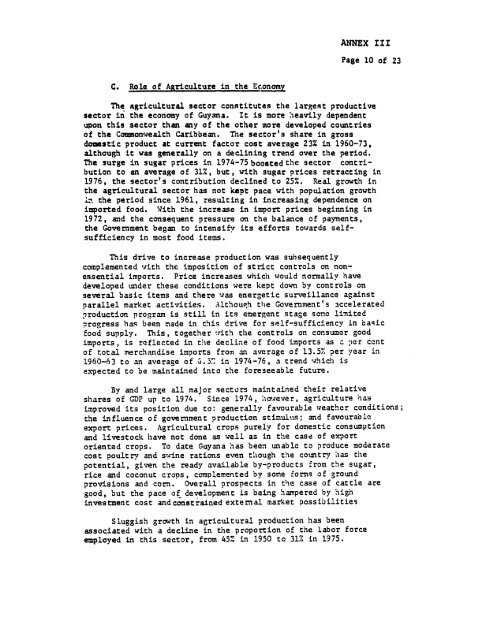MU.,Coo,0O - PDF, 101 mb - usaid
MU.,Coo,0O - PDF, 101 mb - usaid
MU.,Coo,0O - PDF, 101 mb - usaid
You also want an ePaper? Increase the reach of your titles
YUMPU automatically turns print PDFs into web optimized ePapers that Google loves.
C. Role of Agriculture in the Economy<br />
ANNEX III<br />
Page 10 of 23<br />
The agricultural sector constitutes the largest productive<br />
sector in the economy of Guyana. It is more heavily dependent<br />
upon this sector than any of the other more developed countries<br />
of the Commonwealth Caribbean. The sector's share in gross<br />
domestic product at current factor cost average 23% in 1960-73,<br />
although it was generally on a declining trend over the period.<br />
The surge in sugar prices in 1974-75 boosted the sector contribution<br />
to an average of 31%, but, with sugar prices retracting in<br />
1976, the sector's contribution declined to 25%. Real growth in<br />
the agricultural sector has not kept pace with population growth<br />
In the period since 1961, resulting in increasing dependence on<br />
imported food. With the increase in import prices beginning in<br />
1972, and the consequent pressure on the balance of payments,<br />
the Government began to intensify its efforts towards selfsufficiency<br />
in most food items.<br />
This drive to increase production was subsequently<br />
complemented with the imposition of strict controls on nonessential<br />
imports. Price increases which would normally have<br />
developed under these conditions were kept down by controls on<br />
several basic items and there was energetic surveillance against<br />
parallel market activities. Althotu,h the Government's accelerated<br />
iroduction program is still in its emergent stage some limited<br />
?rogress has been made in this drive for self-sufficiency in basic<br />
food supply. This, together !iith the controls on consumer good<br />
imports, is reflected in the decline of food imports as a per cent<br />
of t.otal merchandise imports from an average of 13.5% per year in<br />
1960-63 to an average of 6.53' in 1974-76, a trend which is<br />
expected to be maintained into the foreseeable future.<br />
By and large all major sectors maintained their relative<br />
shares of GDP up to 1974. Since 1974, howiever, agriculture has<br />
improved its position due to: generally favourable weather conditions;<br />
the influence of government production stimulus; and favourable<br />
export prices. Agricultural crops purely for domestic consumption<br />
and livestock have not done as well as in the case of export<br />
oriented crops. To date Guyana has been unable to produce moderate<br />
cost poultry and swine rations even though the country has the<br />
potential, given the ready available by-products from the sugar,<br />
rice and coconut crops, complemented by some forms of ground<br />
provisions and corn. Overall prospects in the case of cattle are<br />
good, but the pace of development is being hampered by high<br />
investment cost and constrained external market possibilities<br />
Sluggish growth in agricultural production has been<br />
associated with a decline in the proportion of the labor force<br />
employed in this sector, from 45Z in 1950 to 31% in 1975.

















